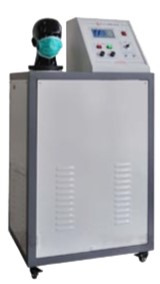
NewsInformation Center
Mask tightness test: is a quick breath enough?
2022/06/23
Mask is worn in the mouth and nose parts used to filter the air in and out of the nose, in order to block harmful gases, dust, droplets, aerosols in and out of the wearer's mouth and nose appliances. Masks are divided into medical and non-medical, China will be divided into three types of medical masks: medical protective masks, medical surgical masks and general medical masks, protection level from low to high. Different types of medical masks follow different standards, and the scope of application varies, and should be selected according to the specific operational requirements, and there are differences in the scope of application and technical requirements of the three standards.
All along, we put too much emphasis on the particle filtration effect of the mask, bacterial filtration effect, synthetic blood penetration resistance and other core indicators, and ignore the requirements for the fit of the mask, you can see that the national standards and documents do not make requirements for the fit of single-use medical masks and medical surgical masks. I do not know, the mask fit test is not in place, will directly affect the other performance of the mask. Mask filtration efficiency is determined by the performance of the filter material selected by the mask, and the protection effect in addition to the filtering efficiency of the mask itself, mask style design is also a key influencing factor. Once the mask and the wearer's face appear larger gaps, particles will leak in from the gaps, resulting in protection failure, it is likely that the filtration efficiency is qualified and the protection effect is not qualified.
What is "tightness"? How to test?
1. Definition of tightness.
If the fit of the mask is poor, it will not help even if it has KN99 filtration efficiency. The outside air can enter directly from the poorly fitted periphery without passing through the mask filter material, so the good or bad fit directly affects the safety of the user.
2. Technical requirements of tightness
If the fit of the mask is poor, it will not help even if it has KN99 filtration efficiency. The outside air can enter directly from the poorly fitted periphery without passing through the mask filter material, so the good or bad fit directly affects the safety of the user.
3. Technical requirements of tightness
Through the fit test penetration, we can check how well it fits and whether it can be fitted to the face after wearing it. As a hospital inductor, when we train or evaluate medical staff to wear masks, we will ask them to cover the mask with their hands after wearing the mask and breathe quickly to see if there is any leakage of the mask, so as to test the tightness of the mask easily. But how to evaluate the tightness of the mask is a very subjective feeling?
4. Test method of tightness
In professional testing institutions, masks are tested in this way! Medical protective masks need to be tested by real people in the test chamber, and particle counters are used to test the concentration of the number of particles; the protective effect of non-medical masks is tested by head models instead of real people, and breathing simulators are used to simulate the breathing process.
In summary, it can be seen that different shapes of masks have different effects on the tightness, and there is no mask that fits perfectly to every face.
However, there are many shortcomings and deficiencies in the current market for medical mask fit testing. Since many standards only require medical protective masks, mask fit testing is characterized by large construction investment but little demand for testing. With the outbreak of the new pneumonia epidemic, the demand for personal protective equipment has surged, especially for medical protective masks, stimulating the demand for mask testing. However, at present, most of the mask testing instruments, breathing simulators, head molds, jigs and accessories are specially developed devices rather than general testing instruments and equipment, and the promotion of mask testing instruments is low, and professional testing instruments and equipment for masks are only visible in third-party testing centers, manufacturing enterprises and other laboratories, while almost no professional mask fit testing is seen in hospitals and other institutions with high usage rates and high professional requirements. The instrument.
Do you want to know more about the testing instruments produced by face mask detection company? We have summarized here 4 features of N95 Face Mask tester, click to learn!
Previous: 4 features of N95 Face Mask tester
N e x t : Constant temperature and humidity aging test chamber humidity sensor 4 major con





